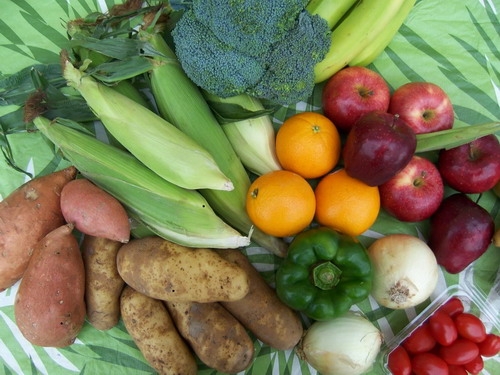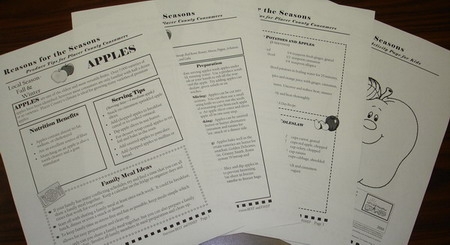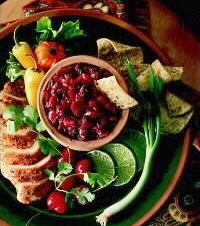Reasons for the seasons
California residents not only enjoy an enviable climate and diverse regions, but also a wide selection of fresh produce year around.
As consumers, we want to stretch our food budget and provide a nutritious diet to our families; but we are not always sure about how to select the best fruits and vegetables, how to store them when we get home, new ways to serve them, and the nutrition benefits they offer.
Placer-Nevada Cooperative Extension has come to the rescue! As part of the Nutrition Best program, UCCE nutrition educators have prepared "Reasons for the Seasons - Produce tips for Placer County consumers," a series of seasonal produce handouts that provide practical information for families and children on purchasing, storing, preparing and serving locally grown seasonal produce.
Each handout also includes tips for families on the importance of family meals and snacks, a couple of tasty and easy-to-prepare recipes, and a coloring page for the children.
News & Information Outreach in Spanish has started to adapt into Spanish these handouts, and produced short video clips. The first one is for strawberries.
To tickle your interest, here is a sampling of some of the tips and information you'll find:
Apples – Over 7,000 varieties have been identified, however most consumers are only familiar with half a dozen or so varieties. Munching on an apple is a tooth cleaner and a gum stimulator. Apples may last up to three months if stored correctly.
Broccoli – Its name comes from the Latin word Brachium which means "branch" or "arm." Broccoli is one of the most nutritious vegetables you can eat. Instead of loading it with a cream sauce that is high in fat, try serving it with silvered almonds, sesame seeds, toasted bread crumbs or parmesan cheese. The leaves can also be eaten and contain more beta carotene than the florets. Store broccoli in an open plastic bag in the refrigerator vegetable drawer. For boiling or steaming, use a non-aluminum pot or pan. Aluminum seems to increase broccoli's cooking odors.
Cherries – Cherries are among the best foods for a snack. The riper the cherry, the larger the size, the deeper the color and the sweeter the fruit. Sour cherries are lower in calories and higher in vitamin C and beta carotene than sweet cherries. You can extend the cherry season by freezing them. They will keep for up to a year in your freezer.
Tomatoes - Botanically, tomatoes are a fruit. This is because, generally, a fruit is the edible part of the plant that contains the seeds, while a vegetable is the edible stems, leaves and roots of the plants. Tomatoes are the leading source of vitamin C in the American diet because of the quantities we eat. Store tomatoes at room temperature for up to one week; longer if still ripening.
Potatoes - Keep the potatoes in a burlap or a brown paper bag. Do not store onions with potatoes. The gases given off by onions accelerate the decay of potatoes and vice versa.
Melons – Most melons originated in the Near East. They are a good source of vitamin A, C and potassium. Serve melons slightly chilled; if they are too cold, you'll miss their full fragrance. Ripe melons are very fragrant, and the aroma of a cut melon can penetrate and effect other foods
Cauliflower – A good source of vitamin C, potassium and fiber. It has been associated with reducing the risk of cancer. Cauliflower should not be cooked in an aluminum or iron pot. It will turn yellow if cooked in an aluminum pot, and blue-green or brown if cooked in an iron pot.
Beets – Beets come in a glistening array of color, from garnet red, to red-white striped, to deep gold, to creamy white. The entire beet, from its robust and flavorful root to its buttery green top, is sweet and delicious. To maintain firmness, cut off beet greens before storing, but leave at least an inch of the stem attached.
May and June are cherry season, so why not look for new ways to enjoy this delicious and nutritious fruit?
Cherry salsa
1/4 cup dried cherries, coarsely chopped
1- 1/3 cups tart cherries, frozen
1/4 cup red onion, finely chopped
1 tablespoon jalapeños, diced
1 clove garlic, peeled and chopped
1 tablespoon fresh cilantro, chopped
1 teaspoon cornstarch
Coarsely chop cherries. Let cherries thaw and drain, reserving 1 tablespoon cherry juice. When cherries are thawed, combine drained cherries dried cherries, onion, jalapenos, garlic, and cilantro in a medium saucepan; mix well. Combine reserved cherry juice and cornstarch in a small bowl; mix until smooth. Stir into cherry mixture. Cook, stirring constantly, over medium-high heat until mixture is thickened. Let cool. Serve with tortilla chips.
This recipe can also be served over cooked chicken or pork
Southwestern-style cherry slaw
Yield: 6 -8 servings
Slaw:
4 cups shredded green cabbage
3 cups sweet cherries, pitted and halved
2 cups torn fresh spinach leaves
1 cup shredded jicama (optional)
1 cup shredded carrot
1/2 cup snipped fresh cilantro
1/2 cup diced red onion
1 avocado, peeled and diced
Toasted pine nuts for garnish
Dressing:
2 tablespoons olive oil
2 tablespoons fresh lime juice
2 tablespoons frozen lime juice concentrate, thawed
1 jalapeno pepper, seeded and minced
1/2 teaspoon lime zest
1/4 teaspoon each chili powder, ground cumin and salt
In large serving bowl, combine ingredients for Slaw. In small saucepan, combine Dressing ingredients; heat to boil. Pour over salad and toss gently to coat. Garnish with pine nuts and serve.
Recipe: Northwest Cherries Online



